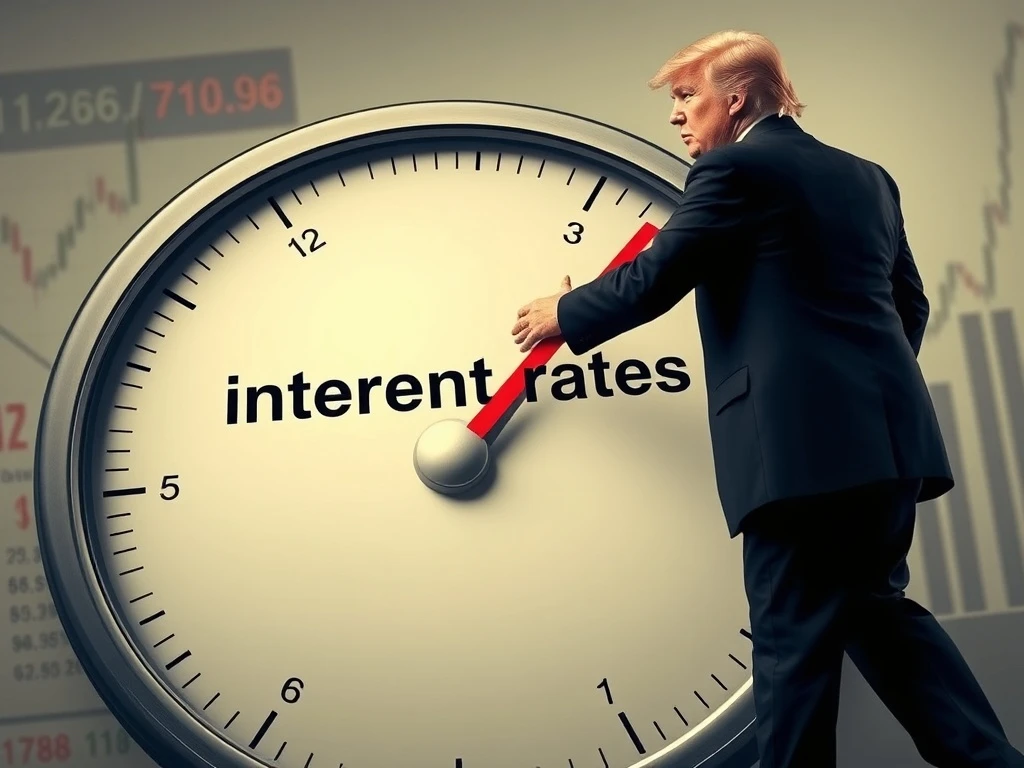The global financial landscape often shifts with central bank decisions. Currently, a significant debate surrounds potential **interest rate cuts** by the Federal Reserve. This discussion draws considerable attention from economists, policymakers, and investors alike. Former President Donald Trump has consistently advocated for substantial reductions. Meanwhile, financial expert Robert Bessent has offered a precise forecast for the magnitude of these anticipated cuts. Their differing perspectives highlight the complexity of economic policy. Understanding this dynamic is crucial for anyone monitoring market movements.
Trump’s Persistent Push for Aggressive Interest Rate Cuts
Donald Trump has long been a vocal critic of the Federal Reserve’s monetary policy. He consistently argues for lower **interest rate cuts**. During his presidency, he frequently pressured the central bank. He believes high interest rates hinder economic growth. Furthermore, he contends they make American exports less competitive globally. Trump often points to other major economies. Many of these nations maintain lower interest rates than the United States. He asserts that a more accommodative stance would boost the stock market. It would also stimulate job creation, in his view.
His arguments typically center on fostering a stronger economy. He suggests that cheaper borrowing costs would encourage business expansion. This would, in turn, lead to increased consumer spending. His calls reflect a desire for rapid economic acceleration. This approach contrasts with the Federal Reserve’s traditional independence. The Fed aims to make decisions based purely on economic data. Political influence is generally resisted by the central bank.
Robert Bessent’s Specific Forecast on Interest Rate Cuts
While Trump advocates for the principle of lower rates, Robert Bessent provides a concrete prediction. Bessent, a well-regarded financial analyst, has offered a specific number for potential **interest rate cuts**. His analysis often delves deep into macroeconomic indicators. He considers inflation trends, employment figures, and global economic stability. His forecasts are based on a data-driven approach. He seeks to identify the precise conditions that would necessitate such a policy shift.
For example, Bessent might analyze core inflation rates. He also examines wage growth and consumer sentiment. His projections often include specific timing. They also detail the potential size of each rate reduction. This level of detail offers a stark contrast to general calls for cuts. It provides investors with a more tangible outlook. His insights help market participants prepare for future monetary policy adjustments. This precision is highly valued in financial circles.
Economic Rationale Behind Potential Interest Rate Cuts
Central banks adjust interest rates to manage economic activity. The primary goals are typically price stability and maximum employment. When an economy slows, central banks may implement **interest rate cuts**. This action makes borrowing cheaper for businesses and consumers. Lower rates encourage investment in new projects. They also make mortgages more affordable. Consequently, consumer spending often increases. This stimulates demand and helps prevent deflation.
Conversely, when inflation rises too quickly, central banks may raise rates. This makes borrowing more expensive. It discourages spending and cools down the economy. The current debate focuses on whether the economy needs a boost. Policymakers must weigh the risks of inflation against the need for growth. Their decisions aim to balance these competing objectives. Therefore, the rationale for cuts is deeply rooted in economic theory.
How Interest Rate Cuts Impact Various Markets
Significant **interest rate cuts** can send ripples across global financial markets. Their effects are widespread and often complex. Here is how different sectors might react:
- Stock Markets: Lower interest rates generally benefit stock markets. Companies can borrow more cheaply for expansion. This boosts their profitability. Also, lower bond yields make stocks more attractive to investors. Technology and growth stocks often see significant gains.
- Bond Markets: Bond prices typically move inversely to interest rates. When rates fall, existing bonds with higher yields become more valuable. New bonds will be issued with lower yields. This impacts fixed-income portfolios.
- Currencies: A country’s currency can weaken with lower interest rates. This is because foreign investors may seek higher returns elsewhere. A weaker currency can make exports more competitive. However, it also makes imports more expensive.
- Real Estate: Lower mortgage rates stimulate the housing market. Homebuyers face reduced borrowing costs. This can lead to increased demand and rising property values. Real estate investments become more appealing.
- Cryptocurrencies: The impact on cryptocurrencies is less direct but significant. When traditional investments offer lower returns, investors may seek riskier assets. Digital currencies, like Bitcoin and Ethereum, are often seen as alternative investments. Reduced bond yields or lower savings account interest can push funds into crypto. This could potentially drive up their prices. Therefore, lower rates often correlate with increased crypto market activity.
The Federal Reserve’s Independent Mandate and Interest Rate Cuts
The Federal Reserve operates as an independent entity. Its primary responsibilities include maintaining price stability and maximizing employment. This is known as its dual mandate. The Fed’s decisions are made by the Federal Open Market Committee (FOMC). This committee comprises governors and regional bank presidents. They analyze a wide range of economic data. Their goal is to set monetary policy in the nation’s best interest. Political pressure, like that from Donald Trump, is common. However, the Fed strives to remain apolitical.
Its independence is crucial for long-term economic stability. It allows the Fed to make difficult decisions. These decisions might be unpopular in the short term. They are necessary for sustainable growth. The Fed communicates its policy decisions clearly. It also explains the economic rationale behind them. This transparency helps markets understand future directions. It builds trust in the central bank’s actions.
Historical Precedents of Interest Rate Cuts and Their Outcomes
History provides valuable insights into the effects of **interest rate cuts**. Central banks have often lowered rates during economic downturns. For example, during the 2008 financial crisis, the Fed cut rates to near zero. This drastic action helped stabilize the financial system. It also stimulated recovery. Similarly, during the dot-com bubble burst in the early 2000s, rates were significantly reduced. These actions aimed to inject liquidity into the economy.
However, the outcomes vary. Rapid cuts can sometimes lead to unintended consequences. They might fuel asset bubbles. They could also contribute to inflationary pressures later on. The 1970s saw a period of high inflation. This was partly due to overly accommodative monetary policy. Learning from these historical patterns informs current policy debates. Policymakers must carefully consider the potential long-term effects of their decisions. Every economic cycle presents unique challenges.
Balancing Risks and Rewards of Aggressive Interest Rate Cuts
The decision to implement aggressive **interest rate cuts** involves a delicate balance. There are clear potential benefits. Lower rates can stimulate borrowing and spending. This can boost economic activity. They can also make it easier for companies to manage debt. Furthermore, they might reduce the risk of a recession. However, significant risks also exist. One major concern is inflation. Too much money chasing too few goods can drive up prices rapidly.
Another risk is the formation of asset bubbles. Low borrowing costs can encourage excessive speculation. This can inflate asset values beyond their fundamental worth. Such bubbles eventually burst, leading to market instability. Policymakers must weigh these factors carefully. They aim to achieve growth without creating new vulnerabilities. The optimal path often involves gradual adjustments. This allows the economy to adapt without sudden shocks.
The ongoing discussion around Federal Reserve **interest rate cuts** remains a focal point for global markets. Donald Trump’s consistent advocacy for aggressive reductions highlights a political desire for economic stimulus. Conversely, Robert Bessent provides a precise, data-driven forecast, offering a detailed outlook for investors. The Federal Reserve, maintaining its independence, will ultimately base its decisions on a complex array of economic indicators. Its path will profoundly influence traditional markets and emerging asset classes like cryptocurrencies. Therefore, closely monitoring these developments is essential for navigating the evolving economic landscape.
Frequently Asked Questions (FAQs)
1. What are interest rate cuts?
Interest rate cuts refer to a reduction in the benchmark interest rate set by a central bank, such as the Federal Reserve. This action lowers the cost of borrowing money for banks, businesses, and consumers, aiming to stimulate economic activity.
2. Why does Donald Trump advocate for interest rate cuts?
Donald Trump believes that lower interest rates boost economic growth, make American exports more competitive, and lead to job creation. He often argues that higher rates hinder the economy’s full potential and place the U.S. at a disadvantage compared to other nations with lower rates.
3. How do interest rate cuts affect the stock market?
Generally, interest rate cuts are positive for the stock market. Lower borrowing costs can increase corporate profits and encourage investment, making stocks more attractive relative to other assets like bonds. This often leads to higher stock valuations.
4. How do interest rate cuts impact cryptocurrencies?
While not directly tied, interest rate cuts can indirectly benefit cryptocurrencies. When traditional investments like savings accounts or bonds offer lower returns due to reduced rates, investors may seek higher returns in riskier or alternative assets, including digital currencies like Bitcoin and Ethereum.
5. Who is Robert Bessent in the context of interest rate forecasts?
Robert Bessent is a financial analyst known for providing specific and data-driven forecasts regarding economic trends, including the potential magnitude and timing of Federal Reserve interest rate cuts. His analysis is often detailed and highly regarded in financial circles.
6. What is the Federal Reserve’s primary role in setting interest rates?
The Federal Reserve’s primary role is to conduct monetary policy to achieve maximum employment and price stability (low and stable inflation). It sets the federal funds rate, which influences other interest rates, to manage economic growth and control inflation, operating independently of political pressure.
















